What do you call a college student with a pair of virgin hiking boots and an outdated (but illustrated) guide from the 1980’s called Backpacking One Step at a Time? The answer is underprepared—and that is exactly how I was feeling after the first day on the trail at Torres del Paine National Park in Southern Chile. I didn’t know how to pitch a tent, I had never used a camp stove, and I had definitely never hiked over 60 kilometers through rugged terrain and unpredictable weather. It was more of a culture shock than my arrival to Buenos Aires, but it proved to be an incredible, hilarious adventure with amazing people—and some pretty spectacular scenic views of course.
I left a gap in my last Patagonia post where the Torres del Paine trek belonged, both to avoid writing a novel about the trip and because it was a completely different kind of adventure. Beginning at the Chilean border crossing and ending on the last rocky decline down the mountains in the national park, it was one of the most (physically) difficult things I have ever done, but it was completely worth it. The gear rental stress, the sloshing wet hiking boots and cold toes, and the sleepless nights in my thin sleeping bag waiting for morning just to start the process all over again were rough, but the hard parts made each triumph that much sweeter and I now have a whole new idea of what I am capable of as a traveler.
Preparations
In my opinion, planning a trip is almost as fun as taking it. I spent weeks poring over blogs and travel guides reading up on the best Torres del Paine backpacking tips, wandering the sparse outdoor outfitters in Buenos Aires, and practice-packing by 50L Osprey pack for the adventures ahead. I had a budget, a checklist, and our large group of four guys and four girls even met up a week before our flight to discuss logistics Everything was perfect, until my worst nightmare occurred. (But feel free to skip ahead to the adventure part of the post!)
Disaster Strikes
Karl and I were sitting in a cafe two blocks from my apartment finishing off our pizza, and I had just gotten back from seeing the doctor after dealing with abdominal pain all week. As we paid the bill and left the restaurant, I began feeling a sharp pain in my left side, and by the time we reached my apartment I could hardly walk. It felt as though I had been shot—I had no idea what was happening, but I knew I needed to get to a hospital.
After a long afternoon of tests, unrelenting pain, and difficulties with my international insurance, I was finally able to receive an IV drip full of painkillers and learned the news that I had a 6.7mm kidney stone passing through my system. The hard part was over, but it was devastating to me that I might not be able to go on the trip that left in less than a week, and after leaving the hospital I had no idea what to expect in the coming days. The doctor who discharged me rushed me out with nothing but a prescription and a short wave, and I believe he just didn’t have the patience to slowly explain any aftercare steps to me in Spanish or find an English speaker around.
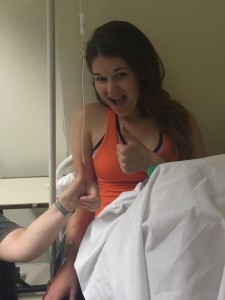
The days leading up to the flight were scary. Although I was only having minor spells of pain (which would have felt extremely major had I not just experienced an instance often compared to childbirth), I had no idea if I should expect another hospital visit, if the pain would go away on its own, or how long it would take for the stone to pass. Of course, the Internet was a poor choice to turn to and only increased my paranoia. Luckily, after several days my host mother took me to a specialist who was very patient with me and explained the current position of the stone in my system, which was almost out, and cleared me to hike Torres del Paine! I was overjoyed, but I wasn’t out of the woods yet.
About ten hours before our flight, I began to experience a pain that was the worst I had had since being in the hospital. I was on my way to an art museum with my classmates, and I needed to take a taxi home because I could hardly walk. The pain grew, but the worst part was that I needed to walk a total of eight blocks to pick up my laundry full of gear for Patagonia before the lavanderia closed at 8:30. Somehow I made it there and back, a small feat but a major victory, and one that got me even more ready for the hike. I thought to myself, “If I could walk eight blocks with a large, jagged kidney stone forcibly careening through my system, I can definitely walk 60 kilometers through Torres del Paine!” Hopeful. With the pain still reverberating through my body, I slowly packed up my gear and tidied my room; I had to leave in about 3 hours and the stone was still going full force. It didn’t help that in Argentina, strong prescription painkillers were not widely used and the ibuprofen dosage my doctor prescribed was less than I normally take for a headache. I took a hot bath and hoped for the best, and around midnight as I put the final touches on my preparations, I felt one last rush of sharp pain and then it slowly faded. My body and mind must have really been in tune with each other, because somehow my muscles knew that they needed to get that stone out before I headed to Patagonia. Luckily, aside from a little bit of soreness the following day, the pain was completely gone and I was readier than ever for adventure!
Puerto Natales
After several days spent in Tierra del Fuego, we arrived in Puerto Natales, Chile, after an 18-hour travel day and a short layover in Punta Arenas with some delicious (and rare for South America) Chinese food. We stayed at Hostel Agustin, a nice place a few blocks from the main street, which cost $8000 CLP per night (about $13USD). We all had a good nights rest, and woke up bright and early to a delicious hostel breakfast and a full day of rain. We had a long day ahead of us, including gear rentals, meal planning and grocery shopping, packing, and attending the famous “3 O’clock Talk” at Erratic Rock Hostel to go over routes and tips for the W Trek we were about to embark on. As a natural planner, the day was extremely stressful for me, as I unnecessarily felt responsible for everyone around me in making sure that they rented the gear they needed and that we had enough food to last the 5 days that we planned.
We spent most of the day meandering through the town and buying last minute clothing and gear, but as soon as the informational talk at Erratic Rock was over, we hit the ground running and together completed the grocery shopping, bought our bus tickets into the park, rented our gear, and finally at about 2 a.m. everyone was packed and ready to head out in the morning.
Day One- Entering Torres del Paine and the hike to Refugio Grey
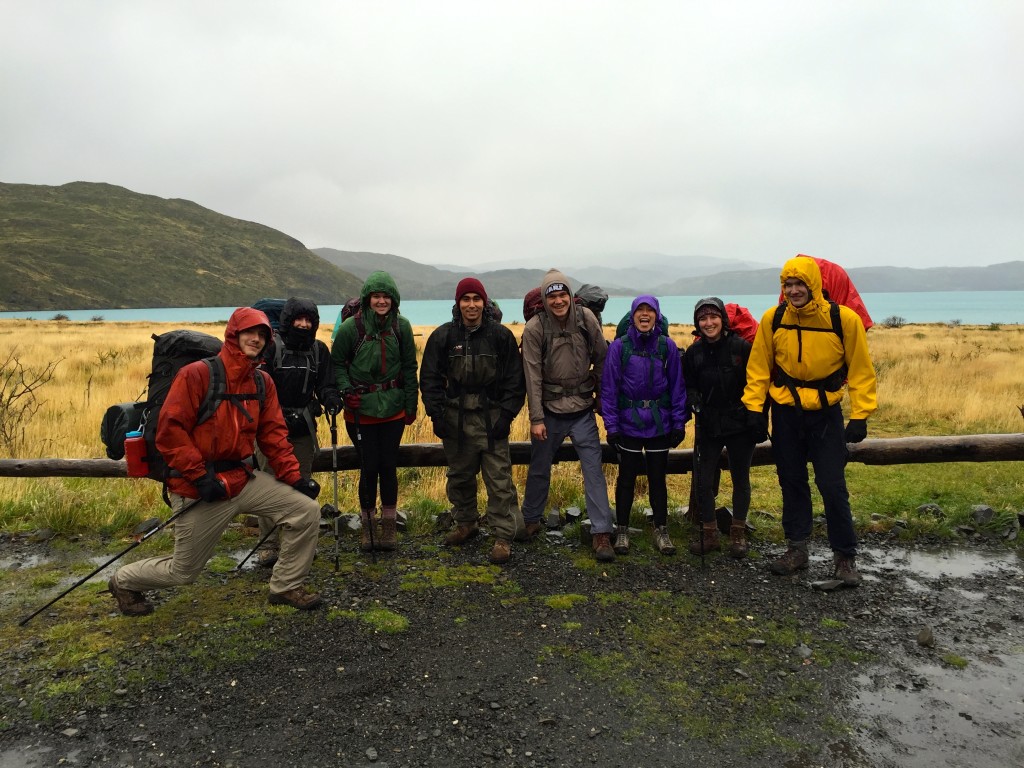
We all arose after several hours asleep and excitedly ate breakfast as we waited for the bus to arrive at our hostel and bring us two hours away to the entrance to Torres del Paine National Park. We were able to leave things in storage at the hostel, such as extra books, shoes, and day clothes, lightening our loads significantly, but we were still each carrying a hefty pack filled with camping equipment, personal gear, clothing, snacks, and full group meals.
The scenic bus ride cost us each 10,000CLP ($16USD) and took us straight to the park entrance, where we paid 18,000CLP to enter. There is one flat entrance rate regardless if you are doing the shorter W Circuit, named for its W-like shape, or the longer 10-day O or Q Circuits, also named as such for obvious reasons. This gave us flexibility and allowed us to go at our own pace. Inside the visitor center, we watched a short video about fire prevention and the “leave no trace” policy, and were free to go.
Because we were hiking the W Circuit from West to East, we were then shuttled to the catamaran crossing so that we could begin the trek at Refugio Paine Grande.
The refugios along the trail are like hostels or hotels that many hikers opt for, but they are very expensive and need to be booked far in advance. They also have paid campsites available with facilities such as showers and mess halls that campers can use. There are free sites, but with little to no amenities. They are rugged, but that’s the fun part about camping, right?
It had been raining all day, but we didn’t realize the magnitude of our situation until we stepped off the catamaran, adjusted our gear, and set off on the first 11 kilometers of the trail to Refugio Grey. One thing that had been repeated to us over and over in our preparations was the unpredictability of the weather in Torres del Paine, and we quickly learned that fact was nothing to be underestimated. We had also heard that the trail markers were seriously incorrect, which we found to be true as well after hiking for under an hour and seeing a marker that indicated we were already one third of the way done. False. We were not even close, and as the rain poured harder and harder, soaking our undershirts and backpacks and flooding our boots, I wondered what the hell I had gotten myself into.
However, I think that the terrible weather (which eventually turned into sleet, never letting up until we reached the campsite) was exactly what we all needed as a wake-up call that this was not an easy hike. By the time we reached Refugio Grey, our muscles and joints were already hurting; morale was clearly low and it was only day one. Were we going to have to hike through four more days of this weather?
Day Two- Refugio Grey to Refugio Paine Grande
To answer that question: absolutely not. The next day, as well as all of the following days, were rainless, sunny, and beautiful. It was like we had won the Torres del Paine lottery, as the park is famous for its unpredictability.
The second day of the West to East hike is typically 11 kilometers back to the beginning, Refugio Paine Grande, and then about 8 more kilometers to Campamento Italiano, one of the free campsites. It was our large group’s first experience with cooking breakfast, packing up all of our tents and gear, and preparing to head out, and we didn’t leave the campsite until 12 p.m., which is extremely late by backpacking standards. Regardless, the hike back—although we were retracing our steps—was incredible. It allowed us to see all the sights that we missed the day before by keeping our heads down and goals forward in the heavy rain, and it definitely lifted our spirits. All in one sweep I could see Glacier Grey, the mountains, and the incredibly blue Lago Grey.
Unfortunately though, we didn’t all make it back to Refugio Paine Grande until about 4 p.m., and at the rate we were going we were not going to make it to Campamento Italiano by nightfall. A tough decision had to be made, and we all decided it would be best to stay at Paine Grande for the night and continue on in the morning, adding an extra day to the trip but easing the shock on all of our bodies. Luckily we had plenty of food and no bookings or commitments that would force us to stick to schedule, and so we set up camp.
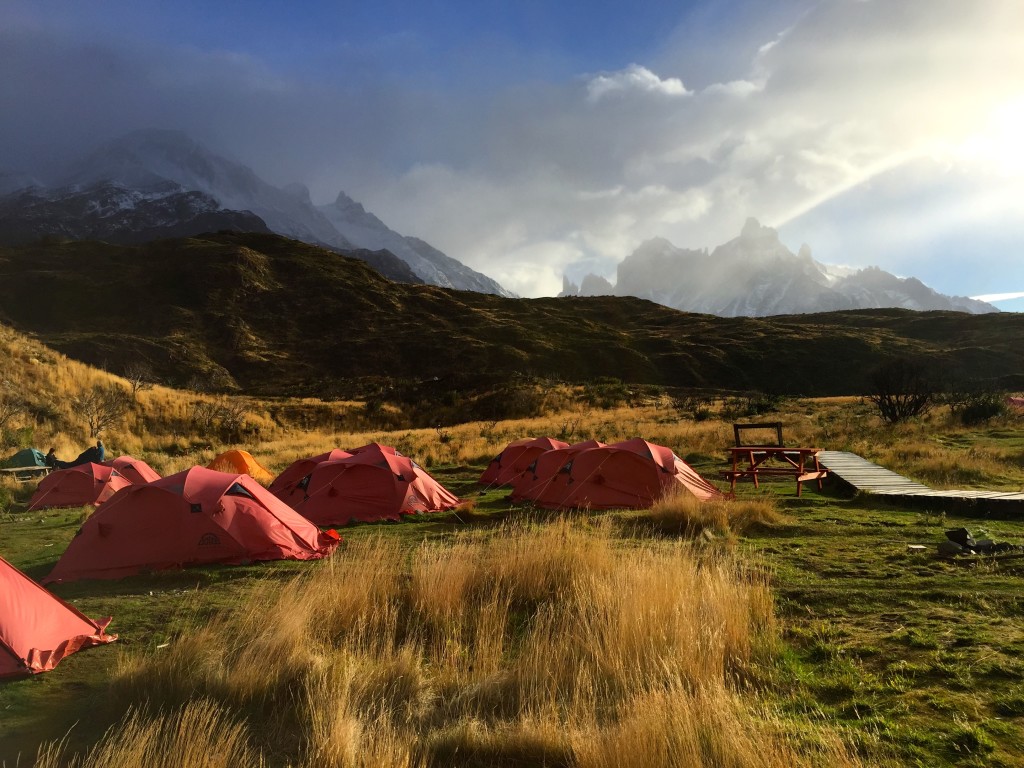
Day Three- Refugio Paine Grande to Campamento Italiano & The French Valley
We woke up much earlier than the first day, quickly ate our oatmeal breakfast, and packed up our gear in a timely manner. We were beginning to get a hang of the backpacking life, and with a fresh night of rest and dry clothes, we were ready to venture on.
Continuing meant we could no longer turn back—Refugio Paine Grande was where the catamaran picked up hikers doing day trips or hiking the route East to West, and at any point one of us could have boarded it, peaced out, and waited in Puerto Natales for the rest of the week waiting for the group. Once we were on our way to Campamento Italiano, the option to turn around was no longer available. Strong-willed, we all left the beautiful campsite and hiked on.
Day three’s hike brought us on a trip through new terrain, which was both refreshing on the eyes and on the body. It was much easier than the previous two days had been, but I was still glad that we chose not to add this portion of the trek to our previous day’s hike. It took most of us under three hours, and we arrived at the free Campamento Italiano with a new excitement for the trip.
Campamento Italiano is also the base camp for hiking up the French Valley mirador, one of the incredible views that Torres del Paine is famous for. Unfortunately due to flooding, we weren’t allowed to hike all the way to the top, but even an hour up proved to be an incredible view of parts of the valley, the towers, and a snow-capped mountain with ruptures, quakes, and avalanches every few minutes. It is so violent and incredible to watch this kind of nature in action.
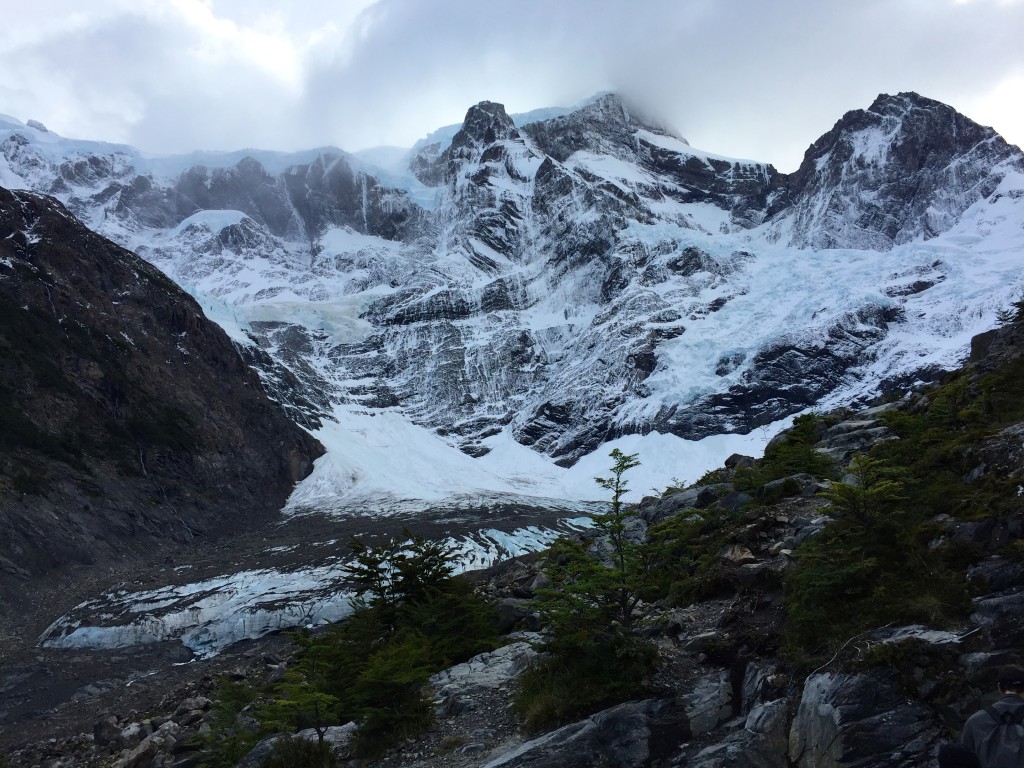
Not all of us hiked up to the mirador—it was a steep, rocky incline along a glacial stream and Alli decided to stay behind due to an injure ankle. We were only gone for about two hours, and when we got back Alli was nowhere in sight.
At first we didn’t think anything of it, but she wasn’t in her tent, in the cooking shed, near the ranger station, or down by the river, and this was not a large campsite by any means. Deep down we knew she was okay, but we waited, searched, and worried for about two hours before Spencer saw her walking out of the woods where she had fallen asleep in her hammock, only about 30 yards from camp.
Meanwhile, Tommy and Karl had gone into super-park-ranger mode, scaling the edge of the riverbanks and following it downstream to make sure she hadn’t drowned. Alli felt terrible that everyone was worried about her, but it was a hilarious situation that showed how much of a team we were all becoming and how we always looked out for one another (I’ll try not to get too sappy though, I promise!).
Day Four- Campamento Italiano to Refugio Cuernos
This is the day that our silly sides came out. We had another short hike in front of us, only about two and a half hours from Campamento Italiano to Refugio Cuernos. Six of the eight of us stay more or less in a pack for the majority of the hike, and we all took a long photo break when we came upon a rock beach on Lago Nordenskjold to practice the art of “Turtling.”
Turtling is what happens when you fall flat on your back with a heavy backpack on, often in a muddy area, and therefore cannot roll yourself over or get up, and are left to flail around helplessly like a turtle on its back. It is far from graceful but often necessary, and I think all of us had at least one instance of turtling during the hike. It is an art that takes practice and is not to be taken lightly, or the Torres del Paine gods will look down on you with shame.
When we got to camp, we paid, claimed our campsites, and soon afterwards dinner ensued. Mealtime quickly became by favorite part of each day, especially dinner. It was a time that we all gathered around the table making strange concoctions with whatever we found at the grocery store in Puerto Natales, joking with one another, and dreading the moment we would have to give up our table to another group and retreat back into our cold tents for another sleepless night.
We had experimented with all sorts of dishes: mushroom soup-packet pasta, instant mashed potato and corn soup-packet chowder, and now tortellini, tomato soup-packet, and powdered milk pasta. Sometimes we added garlic, crackers, or hot sauce, but in reality, if we had been eating this food at home or in a restaurant, we would have been disgusted. After a long day’s hike though, it tasted like heaven and refueled us for the miles ahead.
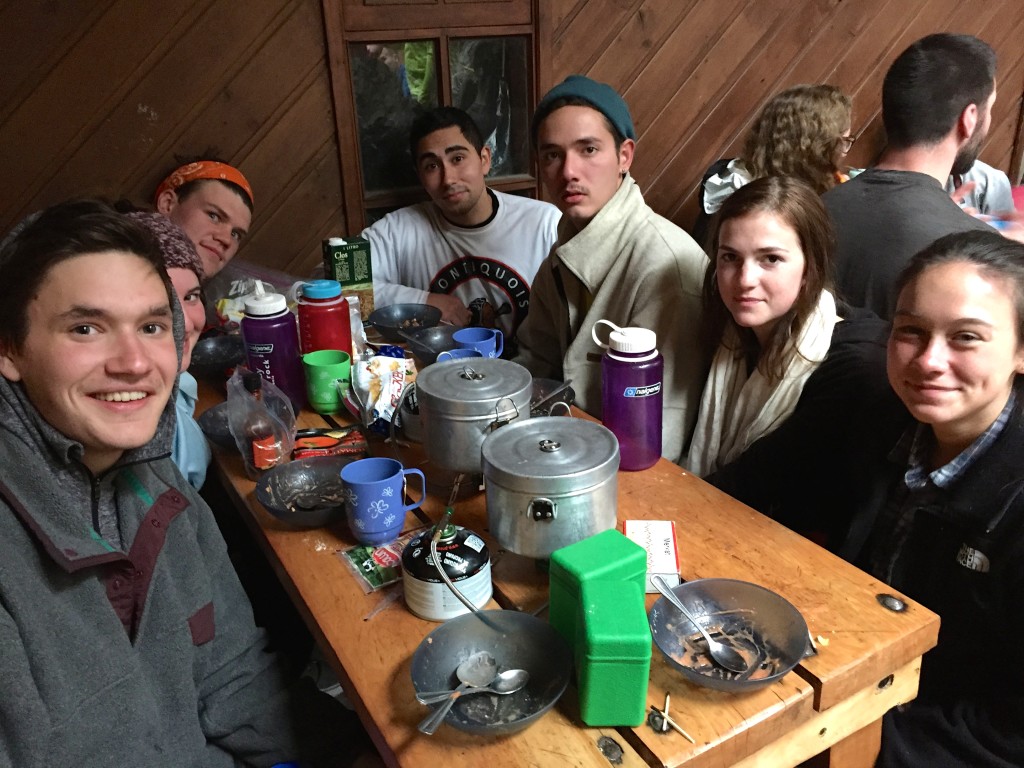
Day Five- Refugio Cuernos to Campamento las Torres
No amount of delicious tortellini could have carbo-loaded me enough for the fifth day, which might have torn my morale down even more than the first. It was 15 kilometers almost exclusively uphill, and it was rough. Karl and I hiked it together, and although we definitely argued—he always wanted to run ahead, turn around, and wait for me to huff and puff my way up all those hills, while I wanted to go at a more leisurely pace to avoid suffocating under the weight of my pack—I probably couldn’t have done it without him, although I was about ready to bite his head off by the time we reached Refugio Chileno five hours later.
There, our group reunited and we relaxed for a spell before continuing on another hour up to the free campsite, Campamento las Torres. This was the last night of camping, and by now we had the set-up process down to a T. I knew all the tricks to setting up our tent, and Karl and I developed roles to make it go quicker: I would set up our sleeping pads, sleeping bags, and backpacks while he put on the rainfly and secured the stakes.
That night, we feasted on all the left over rice packets, soup packets, pasta, and sweets left in our packs since we had not originally budgeted for a fifth night of eating—but we had plenty. It was bittersweet that it would be our last night in Torres del Paine hiking the W Trek, but so far it had been a challenging adventure, and there was still more to come.
Day Six- Campamento las Torres, the Mirador, and the Finish Line
On the final morning, we took the advice of the guide at Erratic Rock and arose an hour before sunrise to hike up to the Mirador las Torres with only our daypacks, a sleeping bag, and breakfast. It was completely dark and only half of us had headlamps or flashlights, but somehow we all made it up the 2 kilometer constant incline to the mirador in time to see the sunrise.
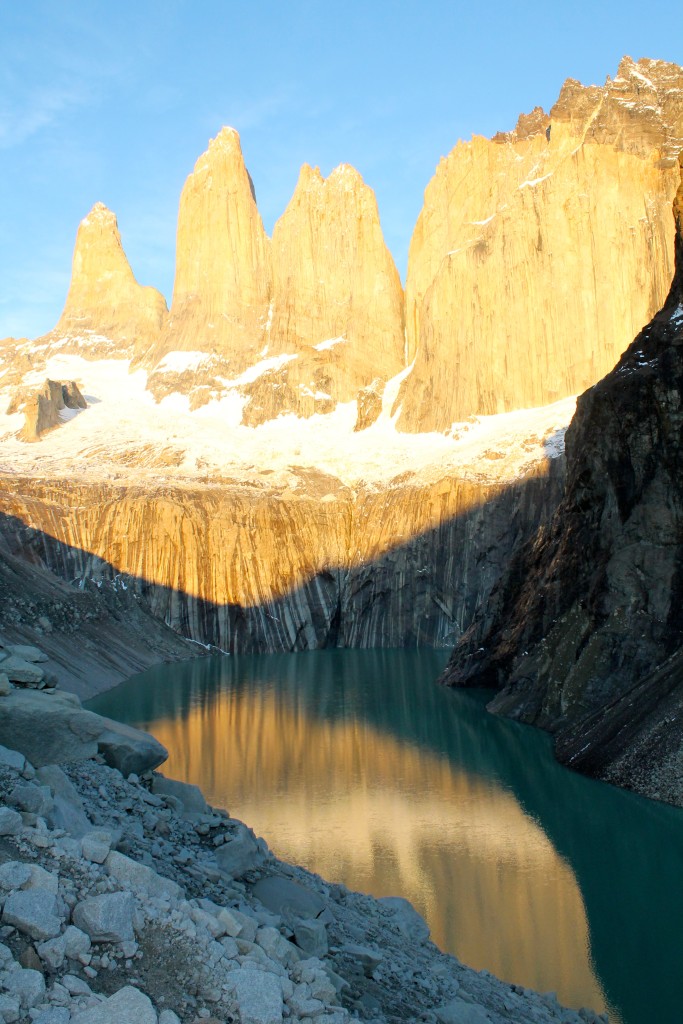
We made it up in one piece, and looked out over the iconic towers of Torres del Paine as the sun rose behind us and the peaks reflected into the pool of water before us. It was really incredible, and as we sat curled up in our sleeping bags munching on granola and chocolate bars, goofing off and hanging out, I felt a strong sense of accomplishment that we had made it all the way to this point and were almost done with the W Trek.
The sky changed from dark pink to yellow and blue, and eventually we had to descend from our lookout point and head back to pack up camp, a task we were finally becoming efficient at. Luckily though, Spencer caught the moment of the sunrise on his GoPro, and even on video its clear to see what all the hype is about of the beauty in Torres del Paine National Park.
Skipping breakfast, we rolled out of camp quickly and hopped, skipped, and jumped down the trail to meet up at Refugio Chileno. When I say hopped, skipped, and jumped, I mean that literally. Most of us, now unconcerned with the state of our knees and ankles since it was the last day, were not only running but flying down the trails, and after we got to the top of the high peak above Refugio Chileno, it was all downhill from there. What is typically a three hour hike took us about an hour and a half, and there were moments that I was running full speed down rocky terrain, passing seasoned hikers shaking their heads at my nonsense and ascending hikers starting the W today probably thinking I was insane. I ran because I had a final burst of energy on the last stretch of the race, the kind that I maintained all throughout high school track and cross-country; it was the mental kind that carries with me in many other aspects of my life, and proves that my mind and body are in tune enough that they can both keep me going until the end, just like they could force the kidney stone out of my body right at the last minute. It felt very freeing, and it was an incredibly rewarding way to end the sixth day.
Mostly though, I was picturing a giant hamburger—a burger the size of a small puppy, complete with fresh ground beef, avocado spread, and a fried egg on top–and that is exactly what all of us got that night after we had gotten back into Puerto Natales and dropped off our gear.
Anyone who knew me growing up would not say I am an outdoorsy person, and that backpacking over 60 kilometers is something a bit out of character for me. Despite that fact and despite the rough patches of the trek, I had the time of my life trying something completely new. I will admit, I was totally inspired by Cheryl Strayed’s book Wild and the movie version featuring Reece Witherspoon, and I wanted to test my endurance and strength in that kind of situation. You won’t find me running off to hike 1,000 miles on the Pacific Crest Trail anytime soon, but I learned a lot more about my limits and how far those can be stretched when pushed.
The best part of the trip was the people I was with. Alli, Emmaray, Morgan, Francis, Spencer, and Tommy are all the absolute most awesome people and I’m so glad I got to make these memories with them. And of course, my boyfriend Karl helped me along the way (more than my pride can admit) and taking this trip to Argentina together was the best decision we could have possibly made.
It’s been real, Torres del Paine. Realistically I will never return, but the adventure I will always remember.
